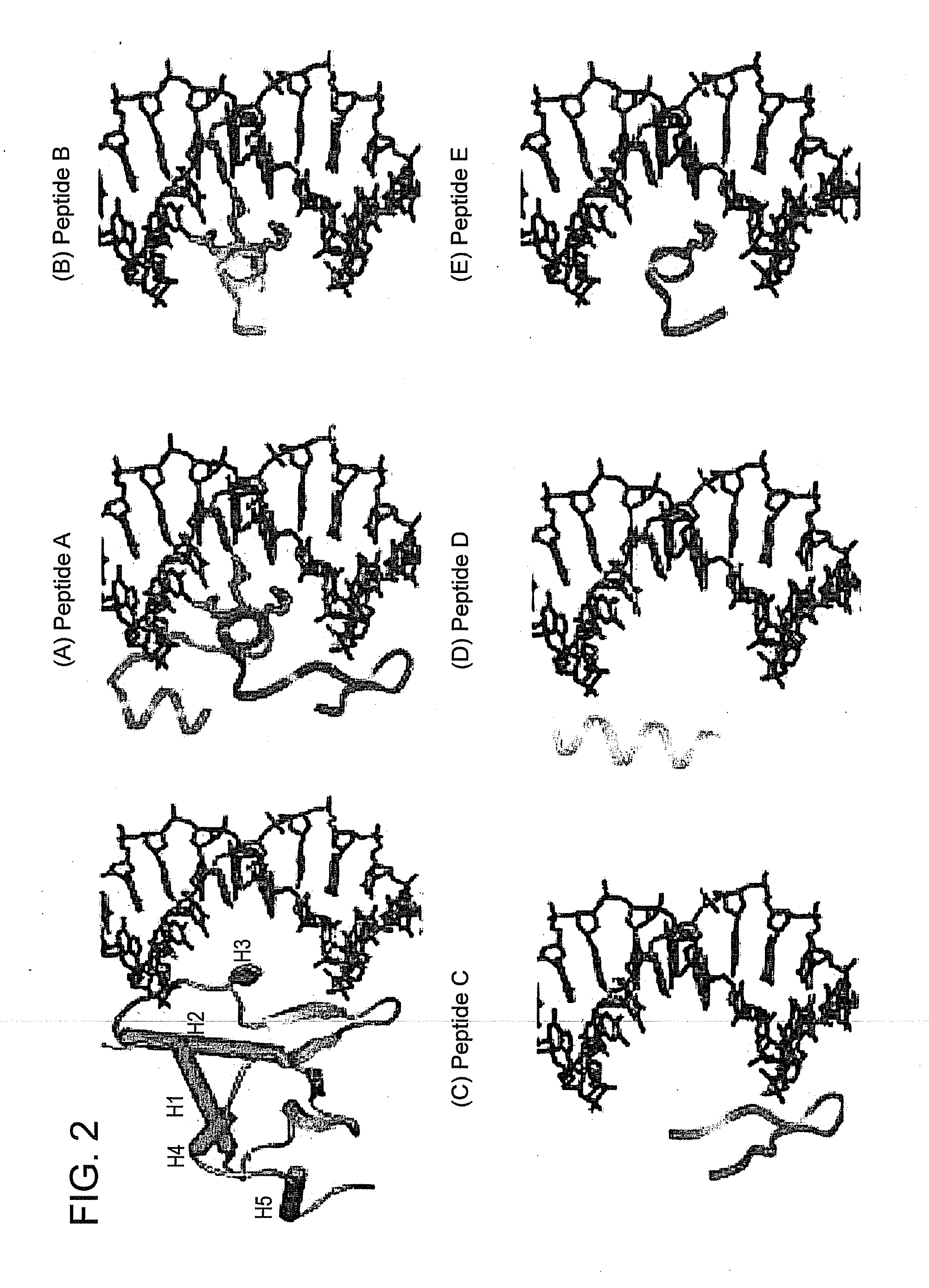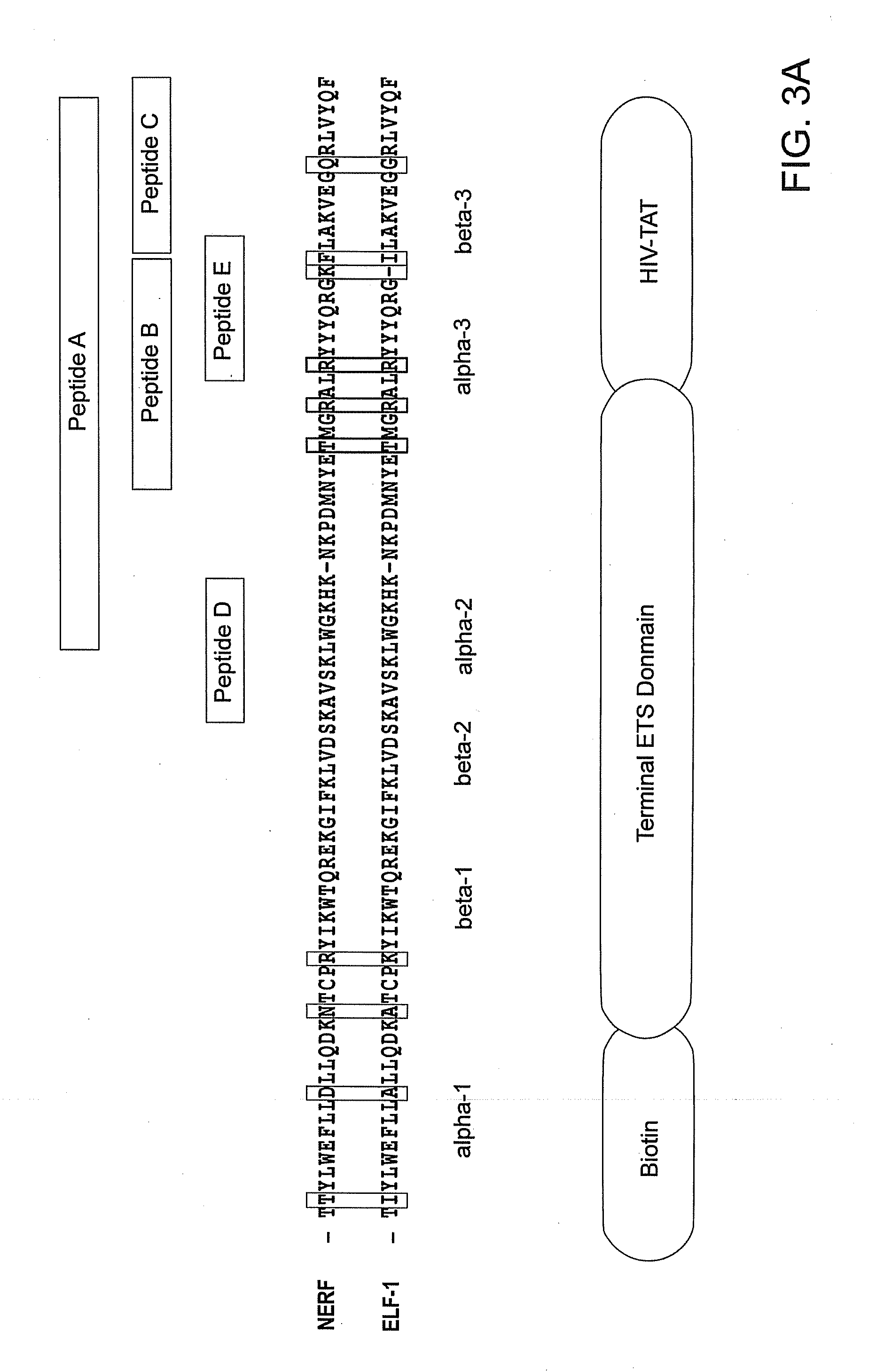Identification and use of small molecules to modulate transcription factor function and to treat transcription factor associated diseases
a transcription factor and small molecule technology, applied in the field of identification and use of small molecules, can solve problems such as refractory interfaces
- Summary
- Abstract
- Description
- Claims
- Application Information
AI Technical Summary
Benefits of technology
Problems solved by technology
Method used
Image
Examples
example 1
Peptide Inhibitors of ETS TF ELF-1 and NRF
[0247]Several recent studies have demonstrated the importance of peptide inhibitors as novel tools in cell biology for understanding and further characterizing the signaling mechanisms mediated by transient P-P and TF-DNA interactions (102). These peptidic approaches have demonstrated significant success, showing therapeutic promise in several disease indications including inflammation and autoimmune disease (1, 103-105). The DBD of the ETS family of proteins is highly conserved at the primary sequence and
secondary structure level. However, the three-dimensional structures of ETS family members are comprised of both structurally conserved regions as well as some unique notable structural differences that are believed responsible for substrate FIG. 2. Using the Xray structure of Ets-1 DBD in complex with its high affinity core sequence, we synthesized ETS peptides (A-E) and assessed their ability to block ETS / DNA gel mobility shift and transa...
example 2
HTD Identification of Small Molecules Targeting the Ets-1 DNA Interface
[0248]Our preliminary data demonstrating that small molecule inhibitors of the TF-DNA interface of Ets-1 could be identified from publicly accessible chemical repositories virtually screened using HTD provides preliminary proof concept data. Ets-1 is an excellent target for this approach due to its critical role in inducing the expression of a number of genes involved in VSMC growth and proliferation, endothelial cell activation
vascular inflammation and cancer ((16, 17, 106) and references therein). Furthermore, we chose this target due to the extensive structural knowledge provided by several crystal structures of Ets-1 in complex with different DNA sequences and / or protein partners (2). In defining the Ets-1 “hotspot” or cavity to be targeted in our HTD studies we actually identified two plausible TF-DNA interfaces that were amenable to this approach
(FIG. 5A, white arrows). Due to the sequence divergence within...
example 3
Cloning, Expression and Purification of Ets-1 DBD for Structural Validation of HTD “Hits”
[0249]NMR provides a robust platform to characterize both the ligand binding site and affinity, while simultaneously providing a window through which the entire target protein or proteins can be structurally observed without the need of an assay to detect this interaction (96, 99). Many of the important advances in the use of NMR in small molecule discovery and optimization have been and continue to be reliant on the recombinant expression of target proteins in E. coli bacterial expression systems to facilitate the preparation of adequate quantities of isotopically enriched target protein. To characterize the mechanism of action of the small molecule modulators identified using HTD, we have recombinantly expressed the DBD of Ets-1. Briefly, a gene insert for the human Ets-1 DNA binding domain (DBD), residues Ile335-Ser420, has been PCR amplified from full-length human Ets-1 cDNA using primers de...
PUM
| Property | Measurement | Unit |
|---|---|---|
| silico quantitative structure activity relationships | aaaaa | aaaaa |
| NMR spectroscopy | aaaaa | aaaaa |
| hydrophobic | aaaaa | aaaaa |
Abstract
Description
Claims
Application Information
 Login to View More
Login to View More - R&D
- Intellectual Property
- Life Sciences
- Materials
- Tech Scout
- Unparalleled Data Quality
- Higher Quality Content
- 60% Fewer Hallucinations
Browse by: Latest US Patents, China's latest patents, Technical Efficacy Thesaurus, Application Domain, Technology Topic, Popular Technical Reports.
© 2025 PatSnap. All rights reserved.Legal|Privacy policy|Modern Slavery Act Transparency Statement|Sitemap|About US| Contact US: help@patsnap.com



